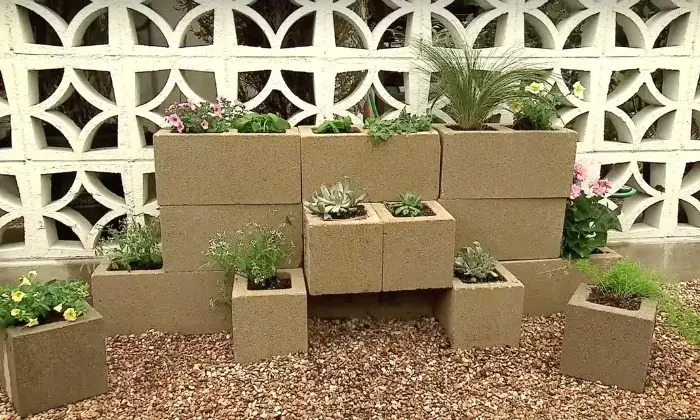These days, more and more people are discovering the joy of playing in the dirt. Of course, grown-ups might prefer the term “gardening.”
Got a dull spot in your yard? A vertical garden will surely solve your problem and it’s very easy to build with cinder blocks!
No mortar and mason’s trowel required. All you need is landscape glue to secure your cinder blocks and you’re ready to plant succulents, flowers, trailers and even herbs to give life to a boring spot.
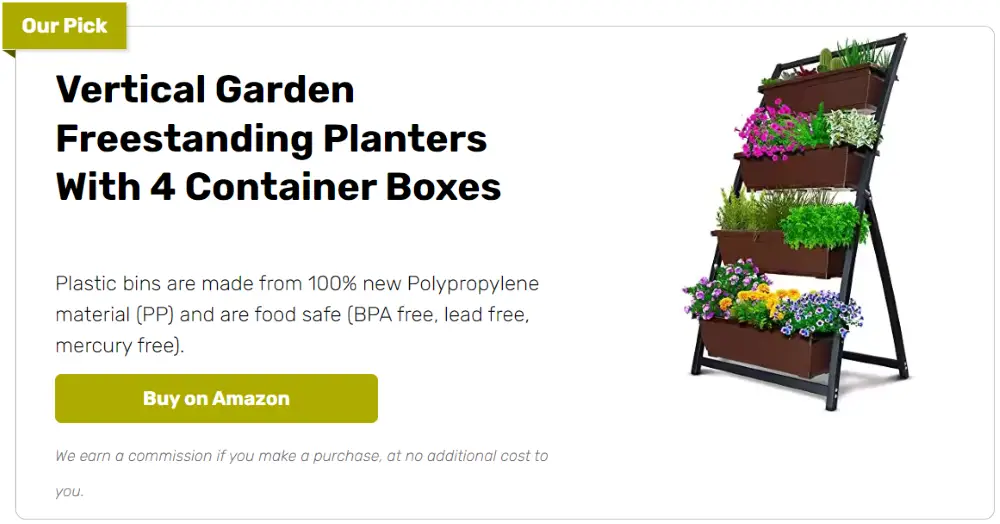
This garden wall is modular so you can definitely arrange it in any way that you want to perfectly fit the space that you have. Go as high as you want as long as you’re confident it won’t fall! ;)
You can also do away with the adhesive in your materials list if you plan to make it low, like the one shown above. This way you can disassemble your garden wall, relocate it or reuse the cinder blocks for other purposes in the future!
Can you see a spot for a cinder block vertical garden somewhere in your home? :)
Contents
Building a Vertical Garden From Cinder Blocks
Materials
- Cinder Blocks
- Potting Mix
- Plants trailer, succulents, herbs, flowers
- Landscape Glue
- Wire Mesh
- Weed Cloth
- Garden Gloves
Tools
- Caulk Gun
- Trowel
- Wire Cutter
- Scissors
Instructions
Step 1: Prepare the Location
- Choose a location for your vertical garden. It should get adequate sunlight based on the plants you’ve selected.
- Clear the area of debris and level it as much as possible to provide a stable base for your cinder blocks.
Step 2: Layout Your Design
- Arrange the cinder blocks in your desired pattern on the ground. Common layouts include a pyramid shape, staggered rows, or a full wall.
- Check the stability of your layout. Adjust as necessary to ensure that the structure will be safe and secure.
Step 3: Secure the Blocks
- If your design is tall or requires additional stability, apply landscape glue between the blocks using the caulk gun. This step is optional for lower structures.
Step 4: Prepare the Blocks for Planting
- Cut weed cloth and wire mesh to fit inside each cinder block hole using scissors and wire cutters.
- Place the weed cloth first to prevent soil from washing out, then add the wire mesh on top to give additional support.
Step 5: Fill the Blocks with Soil
- Wear your garden gloves to protect your hands.
- Use the trowel to fill each cinder block hole with potting mix. Make sure it’s filled to just below the top to leave room for planting.
Step 6: Plant Your Selections
- Choose a mix of plants that will thrive in your climate and sunlight conditions. Consider using trailing plants on the top layers to cascade down, and herbs or flowers in the lower blocks.
- Plant each block carefully, ensuring that the roots are well covered with soil.
Step 7: Water Your New Garden
- Thoroughly water your vertical garden, making sure each plant gets enough moisture.
- During the first few weeks, keep an eye on the moisture level, as cinder blocks can dry out soil quickly.
Step 8: Ongoing Care
- Regularly check your plants for growth, pest issues, and soil moisture.
- Prune as necessary to maintain size and encourage fuller growth.
Click on any image to start the lightbox display. Use your Esc key to close the lightbox.![]()

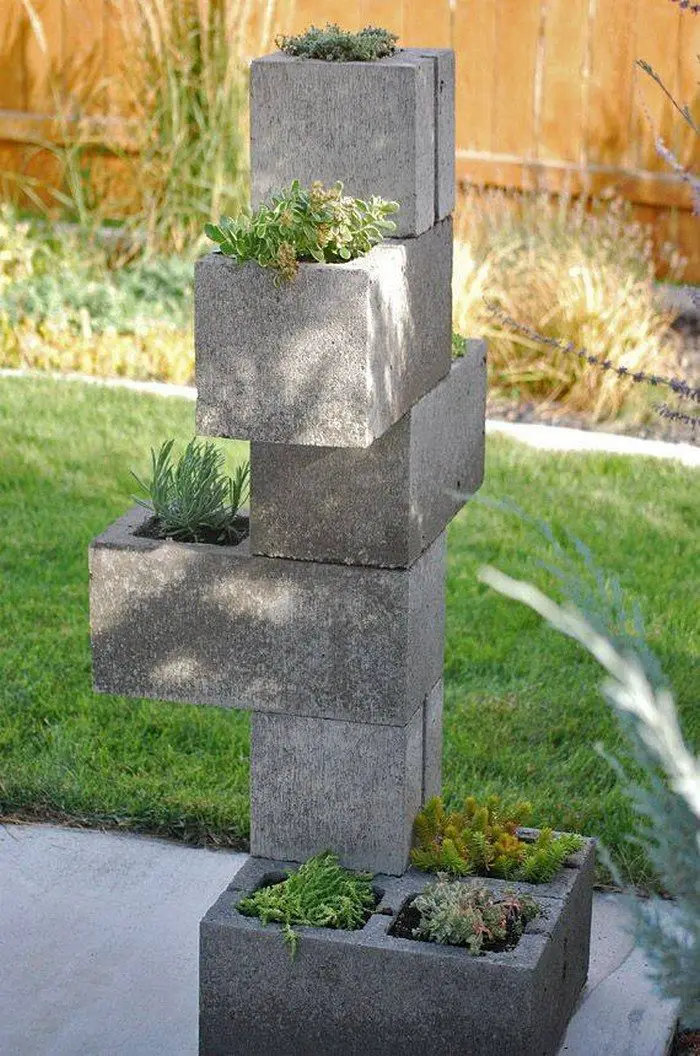

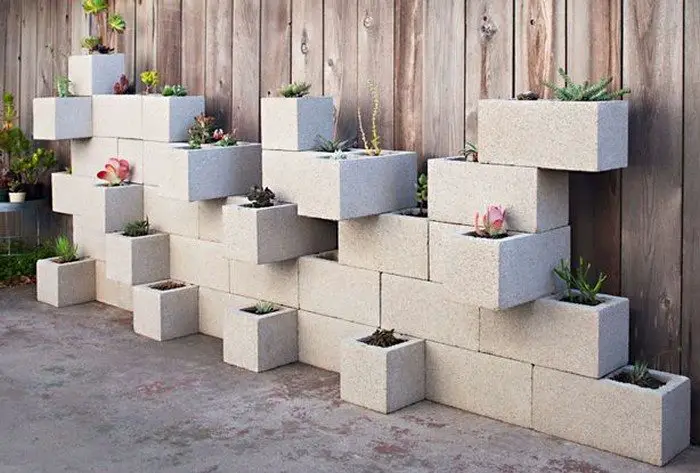
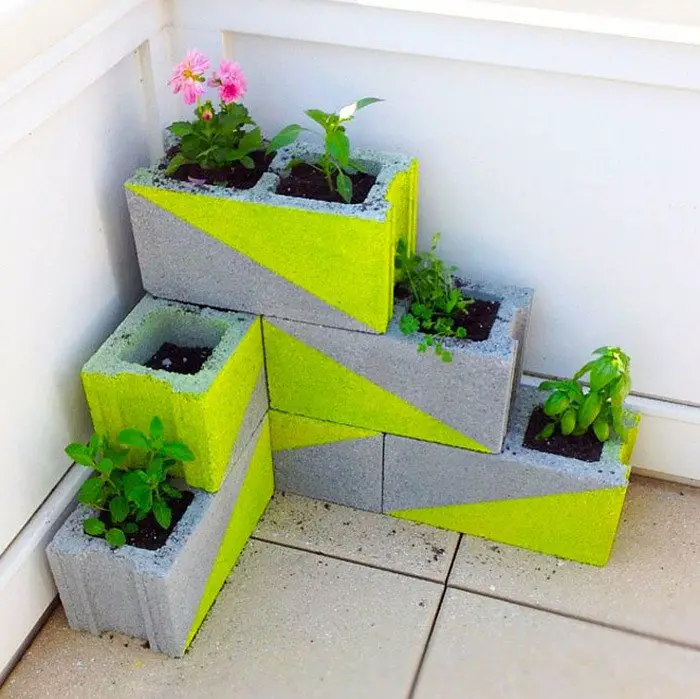

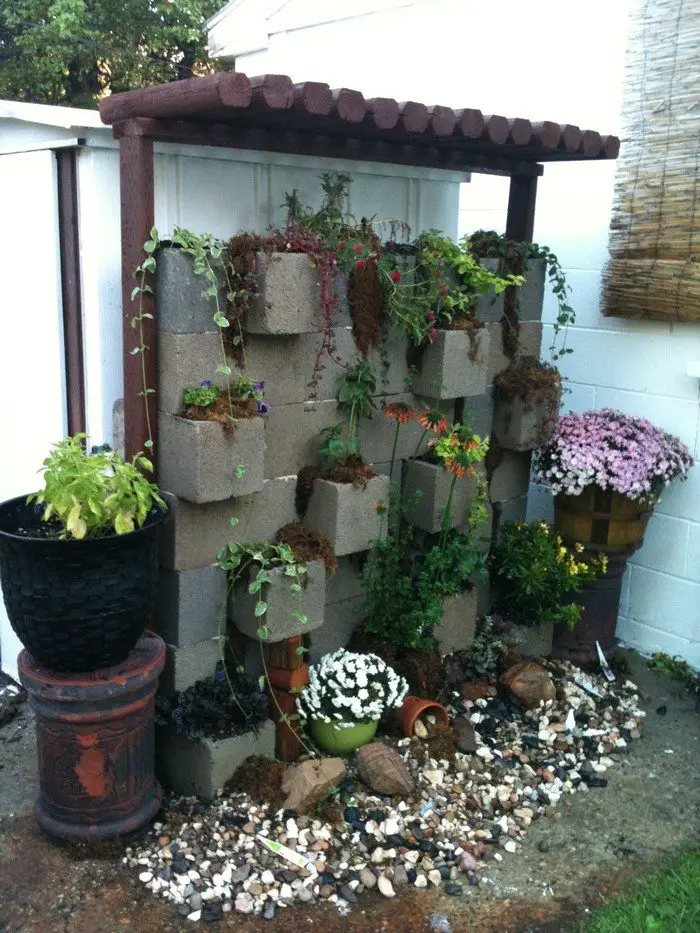

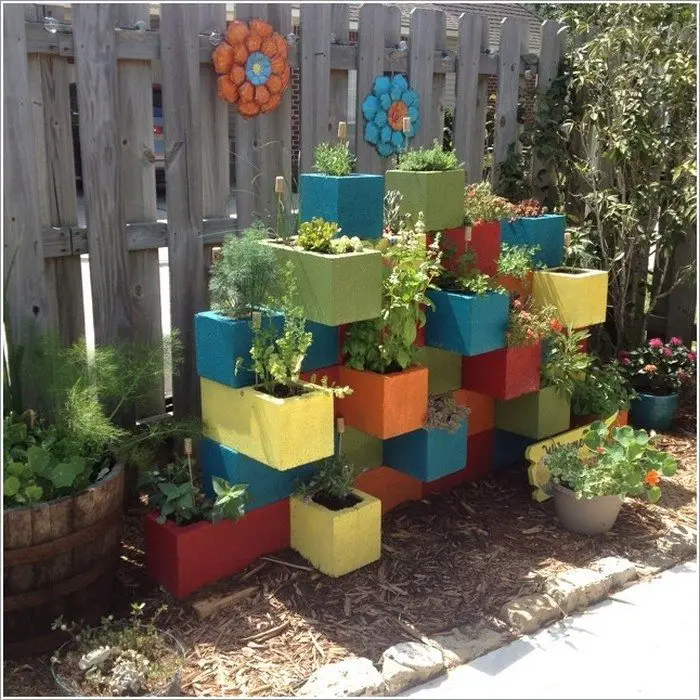
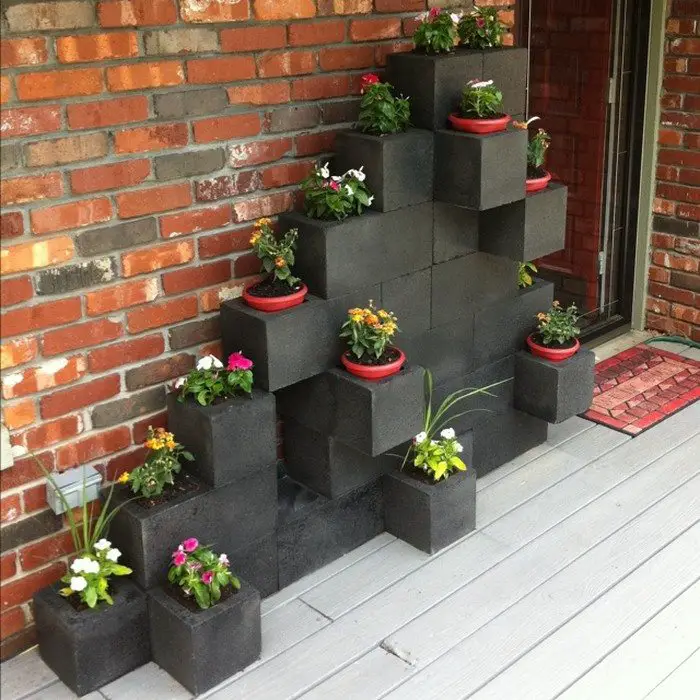
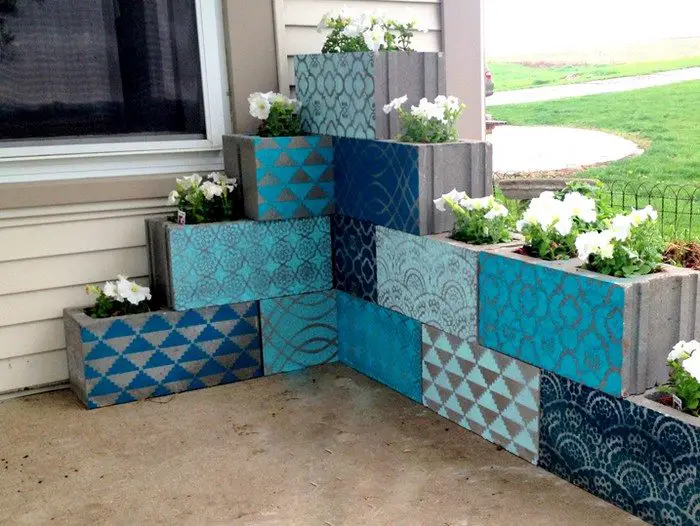

Thanks to Miracle Gro for this great project. You can get step-by-step instructions here…
Here’s a quick video…
Best Plants For Your Cinder Block Vertical Garden
Creating a cinder block vertical garden is an efficient and visually appealing way to grow a variety of plants in limited space. The unique microclimate of each block can cater to different plant needs, making it versatile for various types of vegetation. Here are some of the best plants to grow in a cinder block vertical garden, each chosen for their adaptability, size, and maintenance needs.
Succulents
- Ideal for: Low water areas and full sun exposure.
- Examples: Sedum, Sempervivum, Echeveria
- Benefits: Succulents thrive in the confined, well-drained spaces of cinder blocks and require minimal water. Their varied textures and colors add visual interest.
Trailing Plants
- Ideal for: Top rows of vertical gardens.
- Examples: Creeping Jenny, String of Pearls, Ivy
- Benefits: Trailing plants cascade beautifully over the sides of cinder blocks, enhancing the vertical garden’s aesthetic appeal and covering the harsh lines of the blocks.
Herbs
- Ideal for: Kitchen garden enthusiasts.
- Examples: Basil, Thyme, Parsley, Mint
- Benefits: Herbs grow well in the compact spaces of cinder blocks, making them easy to access and maintain. They need regular trimming, which helps keep them lush and healthy.
Annual Flowers
- Ideal for: Seasonal color and variety.
- Examples: Petunias, Marigolds, Pansies
- Benefits: Annual flowers bring vibrant colors and can be changed out seasonally to refresh the look of your garden. They also attract pollinators, adding life to your garden space.
Perennials
- Ideal for: Long-lasting garden structure.
- Examples: Hostas, Ferns, Daylilies
- Benefits: Perennials are great for the lower sections of a vertical garden where they can spread their roots and return year after year. They offer a consistent structure and foliage to the garden.
Edible Plants
- Ideal for: Edible yields from limited space.
- Examples: Strawberries, Lettuce, Spinach
- Benefits: Growing edible plants in cinder blocks allows for efficient use of vertical space, producing fresh, accessible produce right in your backyard.
Grasses and Sedges
- Ideal for: Adding texture and movement.
- Examples: Blue Fescue, Carex, Pennisetum setaceum
- Benefits: Grasses and sedges can add height and texture to your garden. They are generally low maintenance and add a contrasting form among more traditional flowering plants.
Choosing the right plants for your cinder block vertical garden can lead to a lush and productive garden that maximizes your available space. Each plant type offers unique benefits and can help transform your vertical garden into a diverse and vibrant feature.
Watering and Maintenance Tips
Maintaining a cinder block vertical garden requires specific attention to watering and upkeep to ensure plant health. Given the unique structure of cinder blocks, the distribution of water and nutrients needs careful management. Here are streamlined watering and maintenance tips for your vertical garden.
Consistent Watering
Plants in cinder block gardens may dry out quicker than those in traditional gardens due to their increased exposure to elements. It’s crucial to water consistently, ensuring the soil remains moist, particularly during warmer weather. Employ a watering can with a long spout or a hose with a gentle spray to evenly distribute water without washing away the soil.
Monitoring Soil Moisture
Regularly check the soil moisture by feeling it; if the top inch is dry, it’s time to water. Consider using a soil moisture meter for more accuracy. Adjust your watering frequency based on weather changes, with more frequent hydration needed during hot, dry spells and less during cooler, damp periods.
Nutrient Management
Since cinder blocks provide no nutrients, a consistent fertilization schedule is vital. Apply a balanced, water-soluble fertilizer every four to six weeks during the growing season. Monitor your plants for signs of nutrient deficiencies such as yellowing leaves or stunted growth, and adjust fertilization accordingly.
Pest and Disease Control
Inspect your plants regularly for pests or disease, which can spread quickly in the compact space of a vertical garden. Employ natural pest deterrents and remove diseased plants promptly to prevent issues from spreading. Good air circulation also plays a key role in reducing fungal diseases.
Pruning and Deadheading
Prune overgrown plants regularly to encourage new growth and maintain the garden’s appearance. Deadheading spent blooms is particularly important for flowering plants, as it encourages more blooms and extends the flowering period.
Winter Care
In colder climates, protect perennial plants with burlap or consider moving frost-sensitive plants indoors. During winter, reduce watering and stop fertilizing as plants enter dormancy, helping them to survive the colder months.
These tips will help ensure your cinder block vertical garden remains a thriving and attractive feature, enhancing both the health of the plants and the longevity of the garden. Regular maintenance not only improves plant vitality but also enriches the garden’s overall aesthetic.
Creative Decorating Ideas
A cinder block vertical garden not only serves as a functional space to grow plants but also as a canvas for creative expression. Decorating your cinder block garden can enhance its aesthetic appeal and integrate it beautifully into your outdoor decor.
Here are some imaginative ideas to personalize your vertical garden.
Paint Your Blocks
Adding a splash of paint to your cinder blocks can transform your garden into a vibrant piece of art. Choose weather-resistant paints in colors that complement your outdoor space. For a harmonious look, use shades that match your home’s exterior, or go bold with bright, contrasting colors for a more dramatic effect.
Mosaic Designs
Create mosaic patterns on your cinder blocks using broken tiles, glass pieces, or ceramics. This not only recycles materials but also adds a unique and colorful touch to your garden. Apply the pieces with a strong adhesive and seal them to withstand the elements.
Stenciling
Use stencils to add patterns or inspirational quotes on your cinder blocks. This is a simple way to give your vertical garden a professional-looking design without needing advanced artistic skills. Stencil anything from leaves and flowers to birds and insects, depending on the theme of your garden.
Lighting
Incorporate lighting into your vertical garden for added ambiance. String lights, solar-powered lamps, or LED spotlights can illuminate your plants beautifully at night, transforming your garden into a magical evening retreat.
Plant Arrangement
Experiment with the arrangement of your plants to create visual interest. Use a mix of plant heights, colors, and textures to make your garden look fuller and more dynamic. Trailing plants can soften the edges of the cinder blocks, while upright species can provide height and structure.
Incorporating Art
Integrate small garden sculptures or art pieces among the plants. These can be anything from small birdhouses to decorative garden stakes, adding character and charm to your cinder block garden.
Seasonal Decor
Change up the decor with the seasons. For autumn, consider adding pumpkins and ornamental gourds around your garden. During the winter months, festive decorations like pinecones and ribbons can offer seasonal cheer, even if some plants are dormant.
Using these imaginative decoration ideas, your cinder block vertical garden will be a focal point of your outdoor area and a reflection of your own flair and inventiveness in addition to a place to grow plants.
Conclusion
A great approach to make the most of little space and give your outdoor space a distinctive look is to create a vertical garden out of cinder blocks. This project gives you the freedom to express your own style and the particulars of your area in the planting and decorating. Your cinder block vertical garden will prosper and bring beauty with the right care and upkeep.

